As a dedicated team member at Food and Meal, my culinary journey often intertwines with a quest for comfort and wholesome flavors. Today, I find myself drawn to the kitchen with a particular longing for a dish that encapsulates warmth and nourishment – Soft Tofu Stew. There’s a certain magic in the bubbling cauldron of this Korean classic that beckons me, especially on days when I crave a bowlful of solace. The tender tofu, nestled in a rich and savory broth, has an almost therapeutic effect, promising to soothe not just the palate but also the soul. Join me in this culinary escapade as we delve into the intricacies of crafting a Soft Tofu Stew that transcends its ingredients, transforming into a bowl of pure comfort and culinary delight.
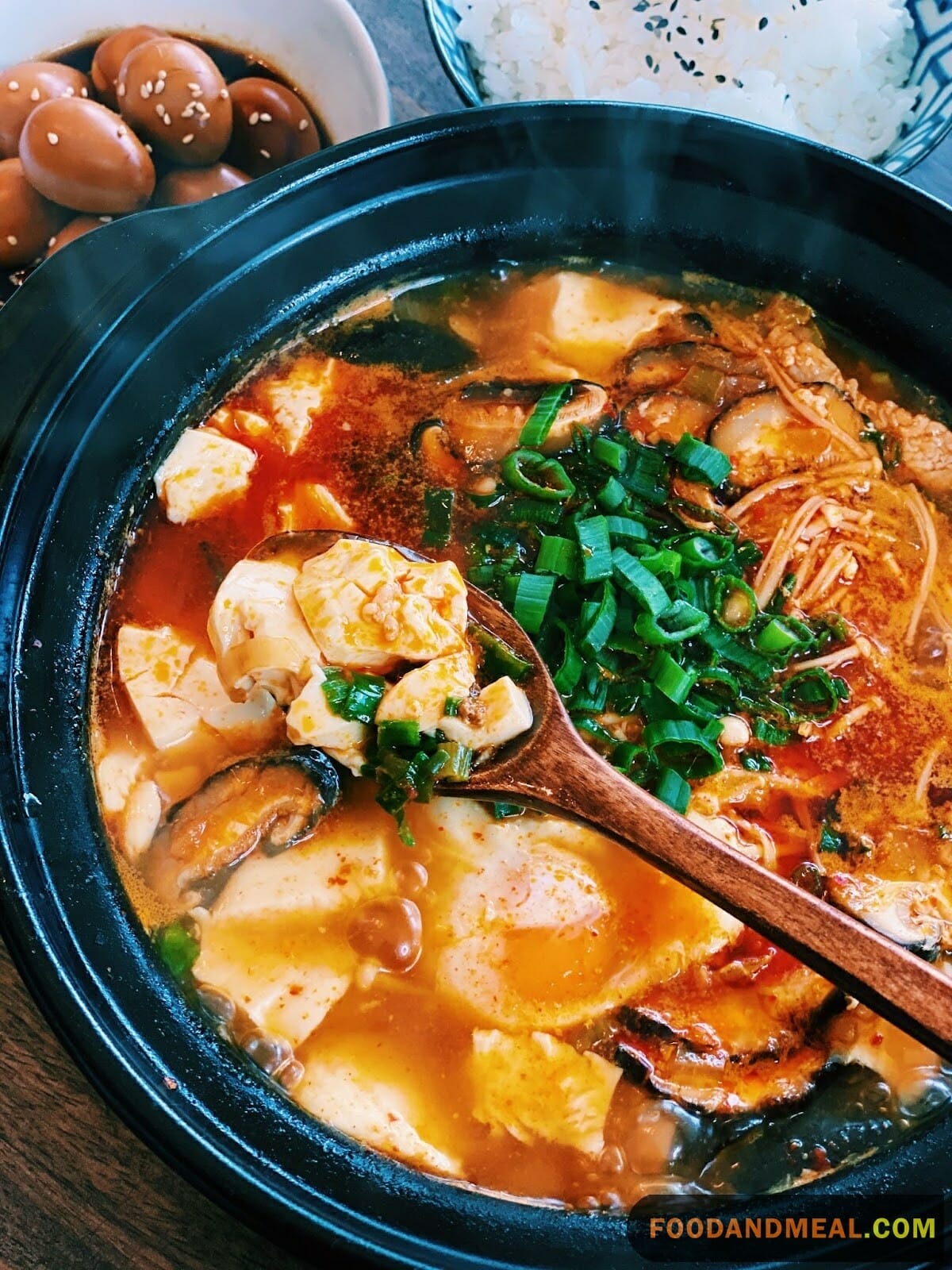
Soft Tofu Stew Recipe
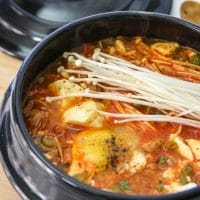
SOFT TOFU STEW
Ingredients
- 2 tablespoons toasted sesame oil
- 1/2 pound thinly sliced beef or pork
- 1/2 tablespoon finely chopped garlic
- 2 tablespoons gochugaru
- 2 cups Anchovy Stock (here), Beef Stock (here), vegetarian stock, or water
- 2 tablespoons soy sauce
- 3 cups soft tofu, cubed
- 11 pound live clams or 1 cup shucked clams, rinsed
- 2 scallions, sliced
- Eggs (optional)
Instructions
- In a stockpot, warm the sesame oil over medium-high heat. Add the beef, garlic, and gochugaru and stir-fry for about 5 minutes.
- Add the stock and soy sauce to the pot, stir, and bring to a simmer. Add the tofu and return to simmer.
- Reduce the heat to medium-low, add the clams, and simmer, uncovered, about 10 minutes, until the shells of live clams open or the shucked clams shrink. Discard any clams that did not open.
- Stir in the scallions and remove the pot from the heat.
- Crack 1 or 2 eggs, if using, into the pot about 2 minutes before you turn off the heat.
Video
Notes
Nutrition
© Food And Meal
This website provides approximate nutrition information for convenience and as a courtesy only. Nutrition data is gathered primarily from the Spoonacular Database, whenever available, or otherwise other online calculators.
Cooking Tips
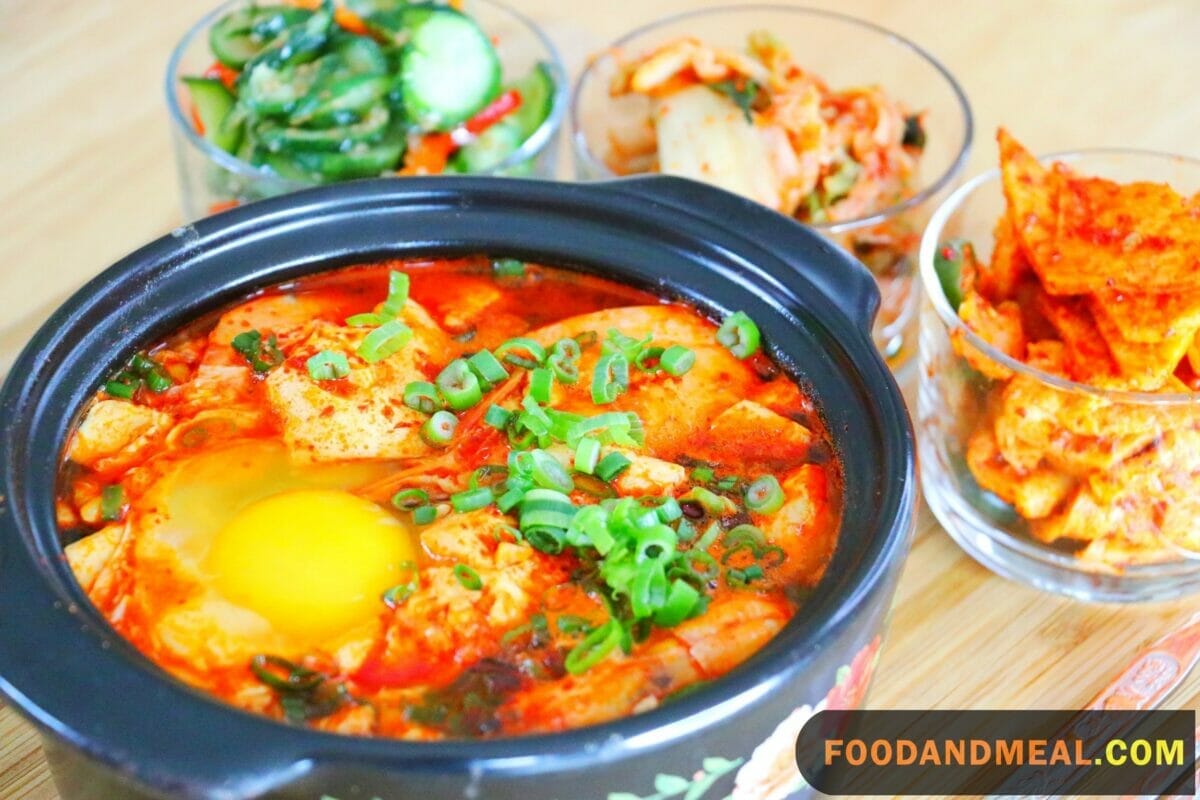
When making sundubu jjigae, I have a few suggestions for getting it just right. First, use the highest quality soft or silken tofu you can find, as this gives the stew its lush texture. Second, add the tofu gently towards the end to keep it from breaking down too much. And third, garnish with toasted sesame oil and seeds for a nutty crunch.
In terms of protein, I like to top mine with sautéed mushrooms, tender strips of beef, or plump shrimp. However you choose to customize this stew, I hope it soothes your soul as much as your appetite. Please tell me your stories over a steaming bowl of sundubu jjigae—I’d be delighted to hear how this recipe makes its way into your lives across cultures.
Serving Suggestions
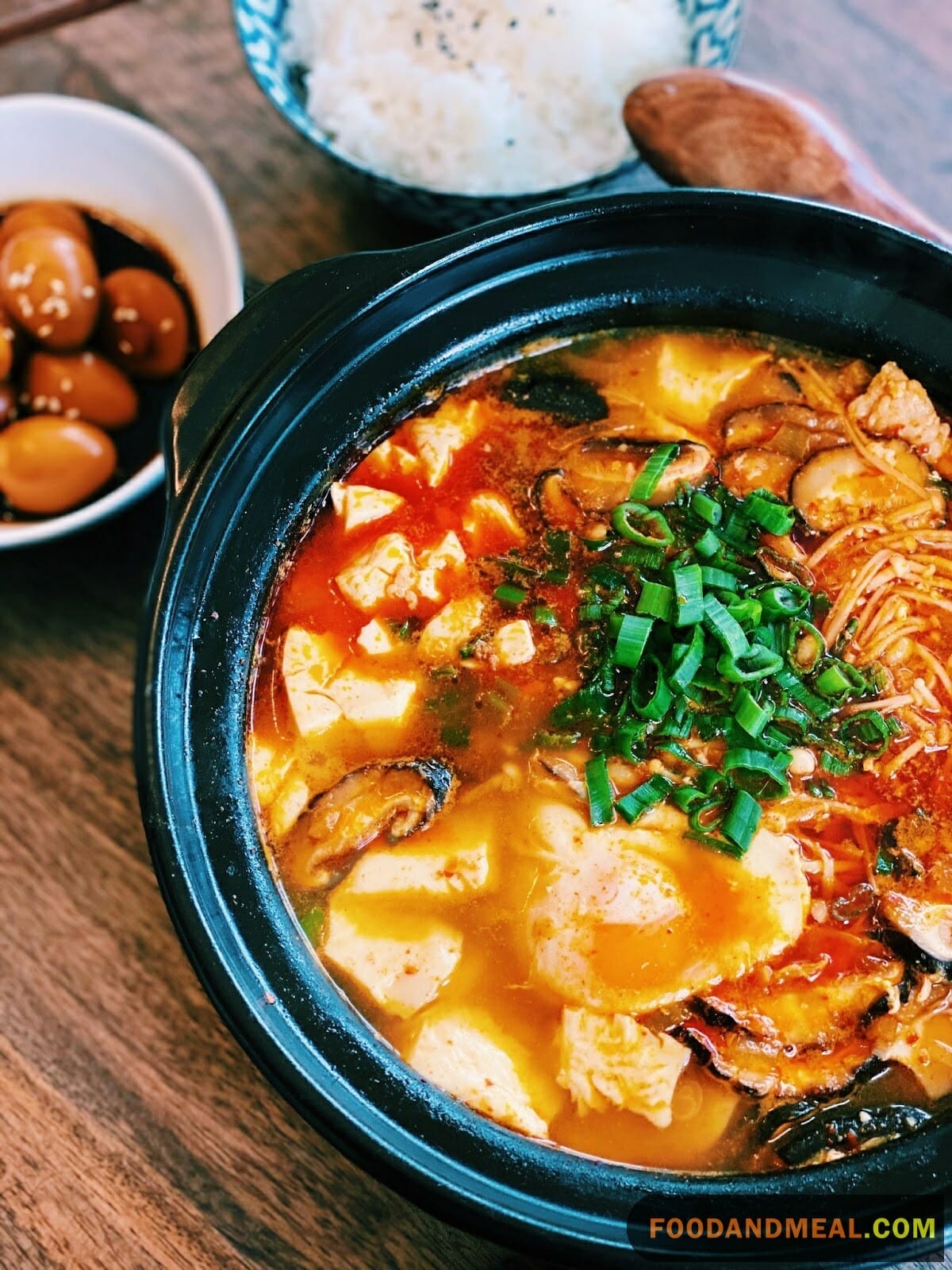
Picture a table adorned with the comforting warmth of Soft Tofu Stew, harmoniously accompanied by the refreshing notes of Hiyashi Chuka (Cold Ramen). The fusion of flavors continues as you indulge in the savory combination of Stir-Fried Beef and Broccoli, creating a perfect balance on your palate. For those seeking a sweet conclusion, the Thai Mango Sticky Rice adds a touch of sweetness that beautifully complements the stew’s savory richness. Take a culinary voyage with the Japanese Sesame Lamb Hot Pot, and explore the depth of flavors it brings alongside the tofu stew. Whether you prefer the autumnal charm of Roasted Kabocha Squash or the refreshing Salmon Cucumber Tartare Bites, these serving suggestions promise a symphony of flavors that will leave you savoring every bite
FAQs of Soft Tofu Stew
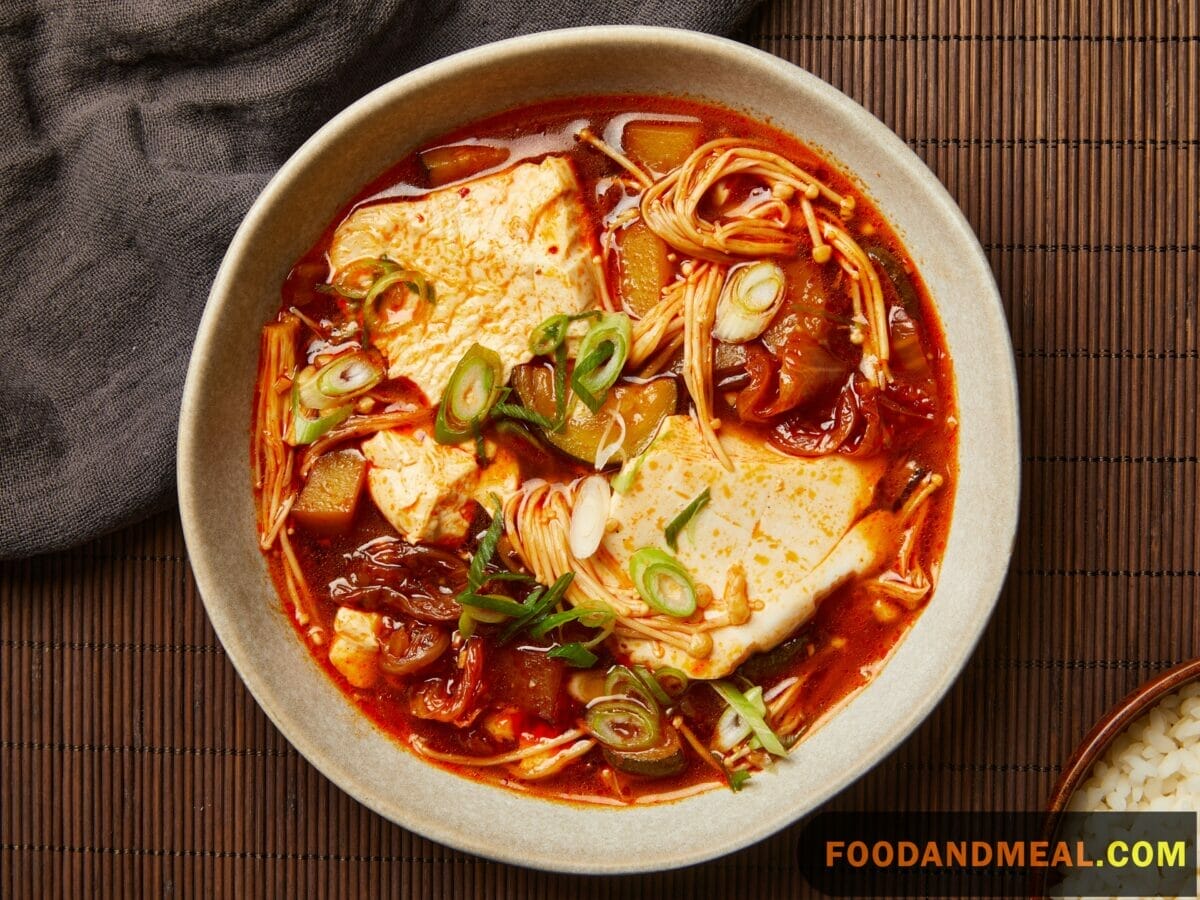
- What is soft tofu stew made of? Soft Tofu Stew, also known as Sundubu Jjigae in Korean cuisine, is primarily made with silken or soft tofu, often complemented by a flavorful broth. Common ingredients include vegetables like zucchini, mushrooms, onions, and sometimes meat or seafood. The stew is seasoned with a combination of soy sauce, gochugaru (Korean red pepper flakes), garlic, and other seasonings to achieve its signature savory and slightly spicy taste.
- Is soft tofu stew good for you? Yes, Soft Tofu Stew is a nutritious and wholesome dish. Tofu, the main ingredient, is an excellent source of plant-based protein, making it suitable for vegetarians and vegans. Additionally, the inclusion of various vegetables adds essential vitamins and minerals to the stew. The broth, often flavored with garlic and other seasonings, not only enhances the taste but may also contribute to overall well-being.
- What is the difference between kimchi stew and soft tofu stew? While both kimchi stew (Kimchi Jjigae) and Soft Tofu Stew (Sundubu Jjigae) are popular Korean stews, they differ in their main ingredients and flavors. Kimchi stew is centered around fermented kimchi, which imparts a robust and tangy flavor. It often includes pork or other proteins and a variety of vegetables. On the other hand, Soft Tofu Stew focuses on the delicate and silky texture of tofu, with a milder taste. While both are comforting and delicious, the key distinction lies in the core ingredients.
- Is Silken tofu the same as soft tofu? Yes, the terms “silken tofu” and “soft tofu” are often used interchangeably. Silken tofu is a type of soft tofu characterized by its smooth and custard-like texture. It is commonly used in dishes where a creamy consistency is desired, such as desserts or silky stews like Soft Tofu Stew. Silken tofu is available in various firmness levels, ranging from extra soft to firm, allowing for versatility in cooking applications.
- Can I Adjust the Spice Level? Absolutely! The spice level of your Soft Tofu Stew is entirely customizable. Simply adjust the amount of Korean red pepper flakes (gochugaru) according to your preference for a milder or spicier outcome.
- What’s the Best Tofu to Use? For that melt-in-the-mouth texture, opt for silken tofu. If you prefer a slightly firmer texture, medium-firm tofu works beautifully. Handle the tofu gently to maintain its delicate form.
- How Do I Prevent Tofu from Breaking Apart? When adding tofu to the stew, use a gentle stirring motion with a wooden spoon or chopsticks. This helps prevent the tofu from breaking into small pieces.
- Can I Make Soft Tofu Stew in Advance? Indeed! Soft Tofu Stew reheats well, making it an excellent option for meal prepping. Store leftovers in an airtight container in the refrigerator for up to 2-3 days. Reheat gently on the stovetop or in the microwave, adding a splash of water or stock to maintain moisture.
- What are Some Vegan Sides to Pair with Soft Tofu Stew? Complement your Soft Tofu Stew with vegan-friendly sides like sautéed spinach, stir-fried bok choy, or a cucumber salad. These dishes enhance the meal with fresh and vibrant flavors.
Conclusion
In conclusion, Soft Tofu Stew emerges as not just a culinary delight but also a wholesome and nourishing dish that satisfies both the palate and the soul. With its delicate balance of flavors and comforting warmth, this Korean classic invites us to embrace the simplicity and richness of home-cooked meals. As we explore the intricacies of Soft Tofu Stew, we discover not only its nutritional benefits but also its ability to evoke a sense of comfort and connection with every spoonful. Whether enjoyed alone or paired with a variety of side dishes, this stew embodies the essence of culinary craftsmanship and culinary satisfaction. For more culinary inspirations and delightful recipes, visit Food And Meal at foodandmeal.com, where every dish is an invitation to savor the joy of cooking and sharing meals together.
Hi! I'm Nazia of ‘Nazia Cooks’, a self-taught baker and cook residing in Chennai. Rooted in the rich South Indian culinary landscape, my palate has expanded to embrace global flavors. I revel in crafting fusion dishes, melding traditions to birth unique tastes.



